Creole Red Beans and Rice is a Southern staple made from red kidney beans simmered with aromatics and smoked meats. If you’ve never tasted the signature dish of Louisiana made from scratch, you are missing out on so much. Canned beans don’t hold a candle to the texture and flavor of dry beans. The snap of a bean when you bite it, the spices and herbs that penetrate the beans…so much of this recipe makes it worth the effort. I was introduced to this dish in New Orleans and have made it once a month since.
The thought of preparing un-canned beans might overwhelm you. Don’t let it. Most of the prep-work when it comes to making it is passive. Meaning, it does its thing while you go about your day.
What Are Creole Red Beans and Rice?
“Creole” anything comes from Louisiana and is considered the more refined cuisine by the state’s residents. When it comes to this particular recipe, though, we can thank escaped Haitian slaves for introducing it to the good folks of Louisiana.
The dish is served with a religious-like commitment on Mondays, which used to be designated laundry days or “wash day.” Instead of laboring over a meal on the busiest day of the week, the hearty red beans puttered away on the stove unattended on Monday and were ready to enjoy by the time all the tedious “washing up” was completed. The leftover ham bone, ham hocks, or pork from Sunday evening’s dinner was the dish’s base flavor the next day, which ensured nothing went to waste.
Cooks in both private homes and restaurants prepare red beans and rice. Like many other native dishes, each family has its own unique recipe for this Southern classic.
What Makes These Red Beans and Rice Creole?
One of the few differences between Cajun cuisine and Creole cuisine is that the latter incorporates tomatoes. In this recipe, tomato paste transforms the plain red beans into Creole red beans.
Besides that subtle difference, Cajun and Creole cuisines differ in the ingredients their cooks had easy access to. I like to say that Creole cooking is the posh steakhouse, while Cajun cooking is the grandma’s kitchen. Both are equally amazing places to get food; one is just more luxe than the other.
When you research the history of Louisiana, it all makes sense. The city-dwelling Creoles had ready access to the butter, creams, a plethora of seafood, and their European forefathers’ cooking techniques. Cajuns in the country just knew how to throw down with what they could get from the land.
Do I Have to Sort the Beans?
Any bean lover worth their weight in legumes will tell you to sort through your dark red kidney beans (or any bean for that matter) three times.
The first two times are practice, my mother used to say, the third is the actual sort. I don’t think that’s the real reason, but there is some truth to it. No matter how well I think I sorted the first two times, I inevitably find an undesirable during my third sort. If you’re a more laser-focused bean-sorter, once or twice is sufficient.
When sorting, you want to remove any beans that look shriveled, broken beyond recognition, or ones that just aren’t up to snuff. It goes without saying that stones, twigs, or foreign particles will also be removed.
After you sort your beans, put them in a colander and give them a rinse under cold running water. Transfer the beans to a large bowl and cover it with at least 6 inches of cold water.
You can replace the traditional red beans in this recipe with pinto beans, white beans, or any other similar type of beans. But the best beans for this recipe are dark red kidney beans. Louisiana red beans are even better if you can find them.
How Long Do I Soak Dried Beans?
You must soak beans, especially dried red kidney beans. Red kidney bean lectin (a protein) is toxic. It isn’t “cyanide potent,” but it will make you regret life while becoming one with your toilet.
The best way to guard against an evening of misery is to soak your dried beans for no less than 6 hours but no longer than 12. I usually sort, rinse, and begin soaking my beans the night before I plan to cook them. Breaking down that lectin begins here.
Once the soaking time is over, strain the water from the beans before giving them another rinse under cold, running water.
You can do a quick soak method by bringing the beans up to a boil in a large dutch oven filled with a gallon of water over medium heat. Turn the heat off and soak the beans, covered, for 2 hours, then drain off the water. Rinse the beans and they’re ready to use.
What Do I Need to Make the Creole Red Beans?
To make this red beans and rice recipe, you need ham broth, chopped yellow onion, celery, and green pepper (otherwise known as the holy trinity), jalapeño, garlic, sofrito (which isn’t Louisiana Creole, but it is tasty), the soaked beans, andouille smoked sausage, diced bacon, tomato paste, bay leaves, and a variety of spices, including creole seasoning (you can replace this with cajun seasoning as well).
The cooking takes place in a 4-quart dutch oven or similarly large pot. This is a one-pot meal, well, kind of, the rice gets made in a separate pot. So, it’s really a two-pot meal, tops.
Can I Replace the Pork Products?
If you are not a pork fan, replace the ham broth with chicken stock or broth. A substitute for andouille sausage is chicken andouille or beef sausage. You can replace the bacon with turkey bacon or omit it altogether and use oil to replace the rendered bacon fat. Replace the meat products and stock with plant-based versions and use vegetable broth for vegan red beans.
In a dutch oven, over medium-high heat, render the fat from the chopped bacon. Add the bacon to the pot before you turn the stove on. As the pot comes up to temperature, the bacon will slowly begin rendering its fat once the stove reaches a low heat. After 2-3 minutes of cooking, there should be about a tablespoon of bacon grease in the bottom of your pot.
Add the sliced andouille sausage to the pot. Stir the sausage in so it’s combined with the bacon. Brown the sausage for 2-3 minutes, or until it takes on a little color.
What Is “The Holy Trinity”?
The holy trinity is an aromatic base in Creole and Cajun cooking. It’s usually equal parts diced onion, green bell pepper, and celery. I say “usually” because, me being me, I add more onion than the other two.
Add the onion, bell pepper, celery, jalapeño, garlic, and sofrito (if you’re using it) to the pot with the sausage and bacon. Give everything a stir and sauté the veggies for 3 minutes, or until they begin to look glossy.
Now it’s time to make it Creole. Add the tomato paste, bay leaf, and the spices to the pot and stir to incorporate it all.
How Long Do I Need to Simmer Dried Beans?
Add the soaked, drained beans to the pot along with the ham broth.
The second step in ridding our beans of lectin (that toxic protein I told you about earlier) is boiling the beans for at least 10 minutes.
Bring the water in the pot up to a rolling boil. Boil the beans for a 10 full minutes. Stir them occasionally to keep beans from sticking to the bottom of the pot.
After boiling the beans for 10 minutes, reduce the temperature to medium low and simmer them for two and a half hours until they have a creamy texture when you taste a couple.
Can I Replace the Dried Beans with Canned?
You can replace the dried beans with the canned beans. I will admit that they do have more of a creamy consistency than dried beans.
To do so:
- Drain and rinse 2 16-ounce cans of dark red kidney beans.
- Add the beans to the pot with half the amount of ham broth.
- Simmer the beans for only 45 minutes.
What Kind of Rice Goes Well with Creole Red Beans?
The best way to serve this red beans and rice dish is with plain white rice. I have tried it with brown rice (too muddy-tasting), basmati (too floral), and even quinoa (just. No). White rice doesn’t jockey for taste here, which is what we need. You want to serve this with a type of rice that will play a canvas to the masterpiece that is the red beans and rice.
Use this recipe to make a batch of steamed White Rice.
Can I Make Creole Red Beans and Rice Ahead?
You can make Creole red beans and rice ahead. In fact, the longer the beans sit, the better the flavors come through. That old saying that the flavors “have married” is an understatement here.
Prepare the Creole red beans and rice as instructed and transfer them to a food storage container. Freeze the beans for 2 months or refrigerate them for up to 3 days.
When you’re ready to enjoy them, just reheat them thoroughly in the microwave or on the stovetop.
How Do I Serve Them?
I always tell people that the name of your recipe tells you how much rice to serve. The Hispanic dish of arroz con habichuelas (rice with beans) indicates a higher rice ratio to beans. This dish, red beans and rice, tells us that we should serve more beans than rice.
Dish out 1/2-3/4 cups of the white rice at the end of the bean’s cook time, then surround it with a generous serving of red beans. I garnish my plate with thinly sliced green onions, but jalapeño slices, parsley, or no garnish at all will work just as fine. A few dashes of hot sauce gives the tender red beans a little kick.
Sweet, Buttery Cornbread is never a bad idea to serve with your Creole red beans and rice. Collard greens are also a great side dish to serve with these red beans and rice. Take my word for it.
How Do I Store Leftovers?
To store leftover red beans and rice, allow them to cool and transfer them to an airtight container. Refrigerate the leftovers for up to 3 days.
Sometimes, as the beans sit, the sauce thickens. If you find your sauce is more of a thick paste, thin it with a bit of ham or chicken broth or water as you reheat it.
Remove the servings of beans you want to eat and reheat them in the microwave or on the stovetop until piping hot.
Can I Freeze Creole Red Beans?
To freeze red beans and rice, transfer the cooled beans to a freezer storage bag. As always, freeze the bag lying flat, so it takes up less space when you stand it up after it freezes solid. Freeze the rice in a separate bag while you’re at it.
The red beans and rice freeze exceptionally well for 2 months.
Making mouthwatering Creole Red Beans and Rice is a straight-forward cooking process that produces some of the best red beans you’ve had this side of southern Louisiana. It just takes is a bit of pre-planning for the soak before you’re set to enjoy a taste of “Da’ Boot” without traveling anywhere but the grocery store (if that). This is a great southern red beans recipe to serve for Mardi Gras, as all of my southern friends can attest to.
Let me know if you agree in the comments below. Be sure to pin this to your boards, then share it with your friends and family.
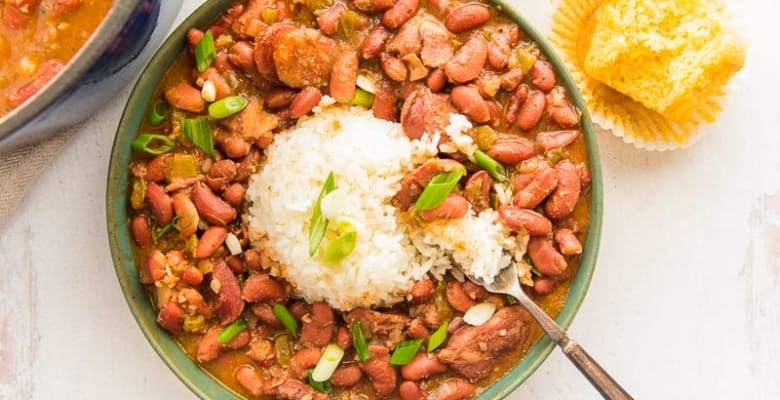
Creole Red Beans and Rice
at Sense & EdibilityEquipment
- 4-quart dutch oven
Ingredients
- 1 pound (454 grams) dark red kidney beans sorted and rinsed clean
- 1/2 pound (170 grams) bacon diced
- 12 ounces (340 grams) andouille sausage (or up to 1 pound), sliced into 1/2-inch thick rounds
- 1 1/4 cups (65 grams) yellow onion diced
- 1 cup (149 grams or 1 medium) green bell pepper diced
- 1 cup (100 grams or 4 stalks) celery diced
- 1/4 cup (8 cloves) garlic minced
- 1/4 cup (1 medium) jalapeño pepper seeded and minced (optional)
- 1/4 cup sofrito optional
- 2 tablespoons tomato paste
- 1 tablespoon cajun seasoning (Tony Cachere's), plus more to taste
- 2 bay leaves
- 2 teaspoons ground cumin
- 1 1/2 teaspoons thyme leaves
- 1/2 teaspoon black pepper plus more to taste
- 1/4 teaspoon ground allspice (optional)
- 6 cups (1 1/2 litres) ham broth (or chicken broth)
To serve
- 8 cups steamed white rice
- jalapeño pepper sliced
- green onions sliced
- cornbread or corn muffins
Instructions
Soak the Red Beans (Begin at least 8 hours ahead)
- Add the sorted and rinsed beans to a large bowl. Cover the beans in the bowl with at least 4-inches of cold water. Soak the dried beans at room temperature for no less than 6 hours but no longer than 12.
- Once the soaking period is over, strain the water from the beans before giving them another rinse under cold, running water.Set aside while you begin the flavoring base.
Render the Fat and Sauté the Aromatics
- Add the bacon to a 4-quart dutch oven.Heat the pot over medium-high heat to slowly render the fat from the bacon. After 2-3 minutes of cooking, there should be about a tablespoon of bacon grease in the bottom of your pot.
- Add the andouille sausage to the pot. Stir the sausage and bacon together, then brown the sausage for 2-3 minutes, or until it takes on a little color.
- Stir the onion, bell pepper, celery, garlic, jalapeño, and sofrito (if you're using it) into the pot with the sausage and bacon. Sauté the veggies for 3 minutes, or until they begin to look glossy.
- Add the tomato paste, cajun seasoning, bay leaves, cumin, thyme leaves, pepper, and allspice to the pot and stir to incorporate everything.
Add, then Simmer the Beans
- Add the soaked, drained beans to the pot. Stir in the ham broth. Bring the liquid in the pot up to a rolling boil. Boil the beans for a 10 full minutes, stirring them occasionally to keep beans from sticking to the bottom of the pot.
- After boiling the beans for 10 minutes, reduce the temperature to medium-low and allow the beans to simmer for 2 1/2 hours, or until just tender. The beans should offer a bit of resistance when bitten into, but shouldn't be crunchy.If they are still too hard, continue simmering for another 15-20 minutes, or until tender.
Notes
An important note about red bean lectin:
The soaking, and 10-minute boiling the beans later on in the recipe is not optional. The toxic lectin in the beans is removed during these steps.Pork Alternatives:
- Turkey bacon (or oil) and chicken andouille or beef polish kielbasa (odesskie) can replace the bacon and the andouille sausage.
- Replace the ham broth with chicken broth.
To Use Canned Beans Instead of Dried:
- Drain and rinse 2 16-ounce cans of dark red kidney beans.
- Add the beans to the pot with 3 cups of ham broth instead of 6 cups.
- Simmer the beans for only 45 minutes.
Make-Ahead Instructions:
- Prepare the Creole red beans and rice as instructed.
- Transfer them to a food storage container.
- Freeze the beans for 2 months or refrigerate them for up to 3 days.
Storage Instructions:
- Transfer the cooled red beans and rice to separate storage containers. You can also combine the two into one large container.
- Refrigerate the leftovers for up to 3 days.
- Sometimes, as the beans sit, the sauce thickens. If you find your sauce is more of a thick paste, thin it with a bit of ham or chicken broth or water as you reheat it.
- Remove the servings of beans you want to eat and reheat them in the microwave or on the stovetop until piping hot.
- Spoon the beans over the warmed rice.
Freezer Instructions:
- Transfer the cooled beans to a freezer storage bag. Freeze the bag lying flat, so it takes up less space when you stand it up after it freezes solid.
- Freeze the rice in a separate bag.
- Red beans and rice freeze exceptionally well for 2 months.
- Thaw the beans (and rice) under refrigeration.
- Reheat the beans thoroughly in the microwave or on the stovetop.


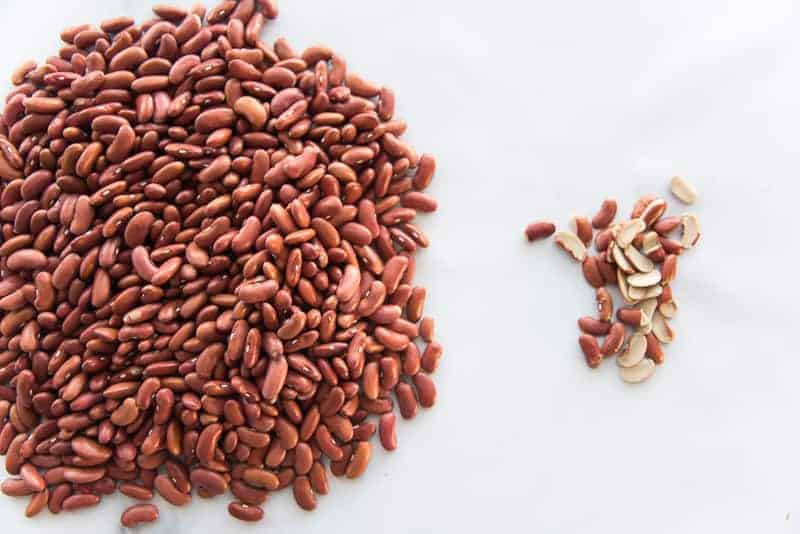
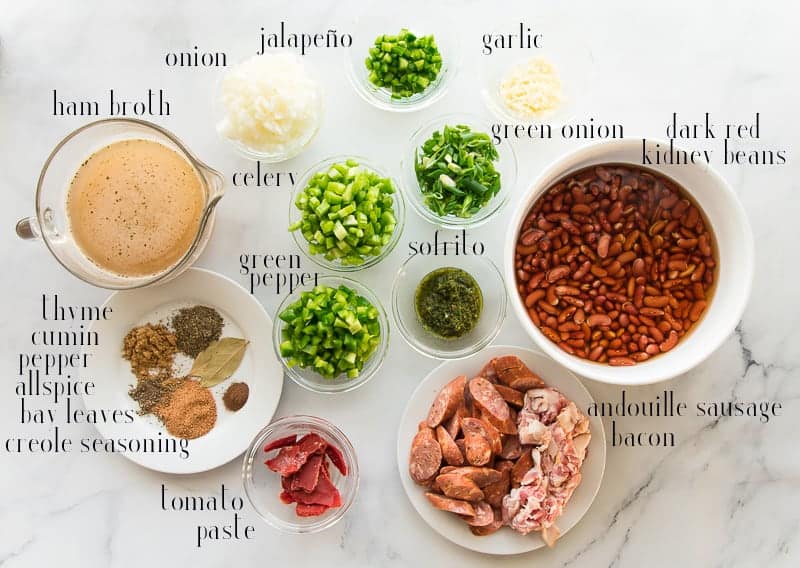
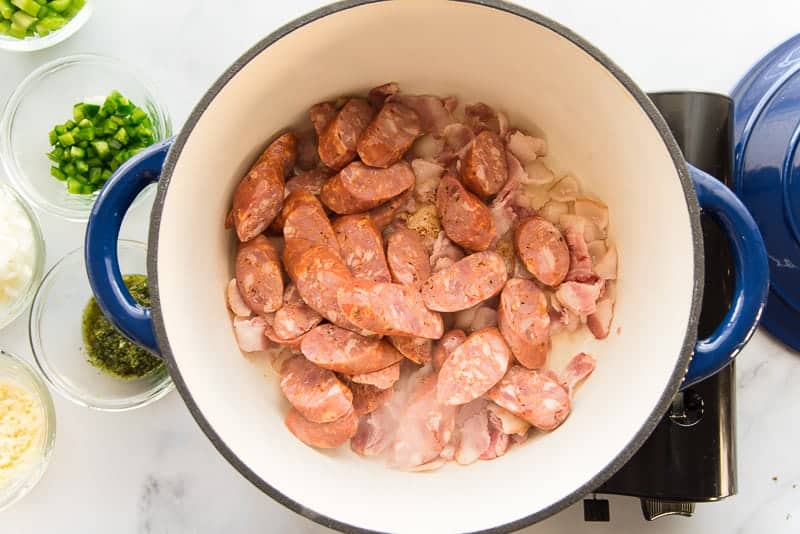
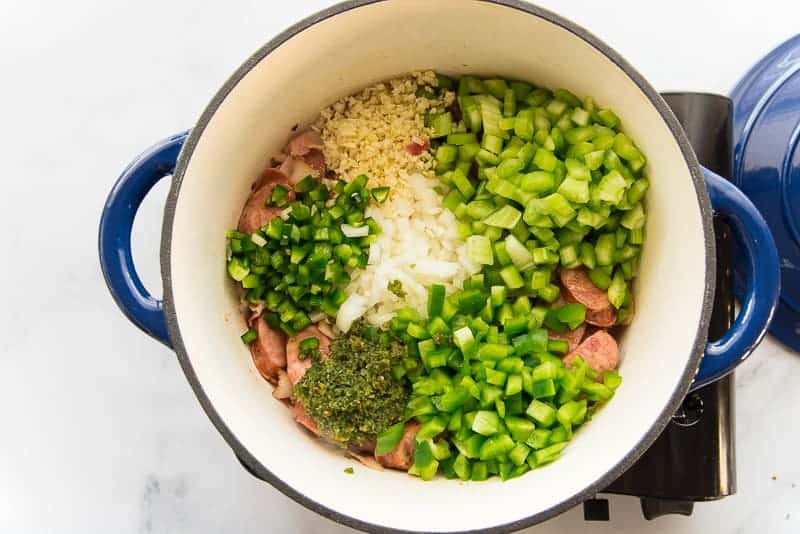
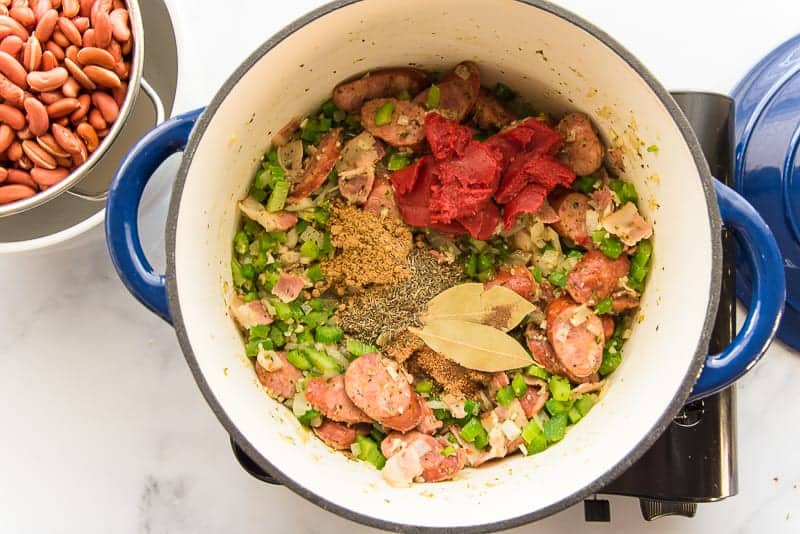
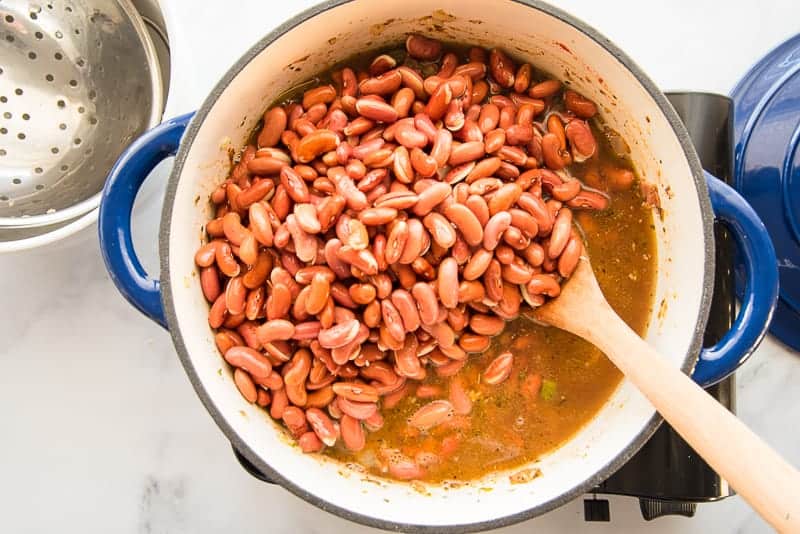
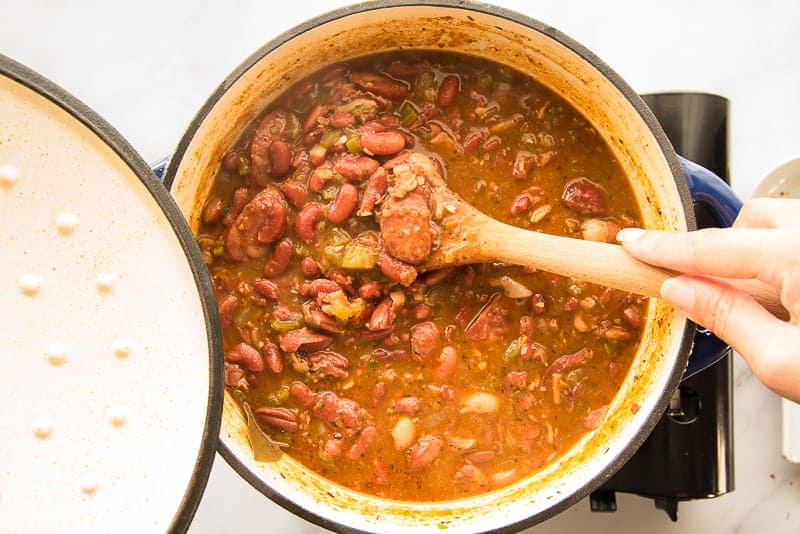
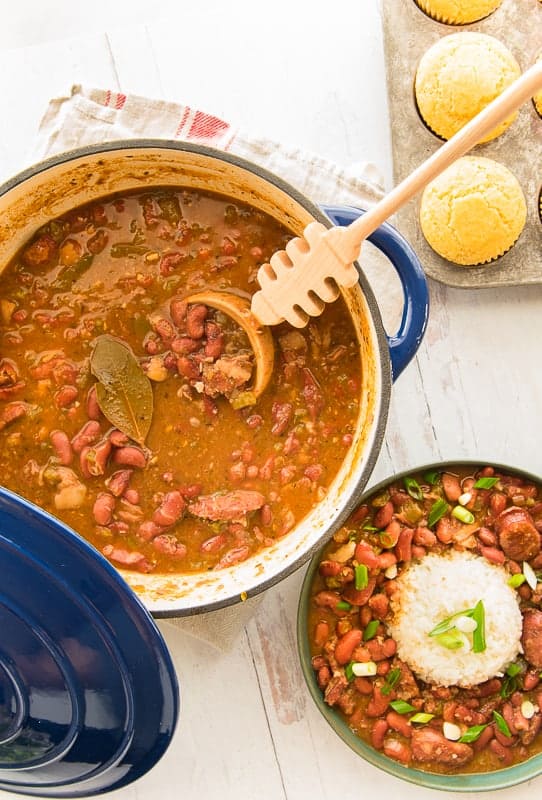
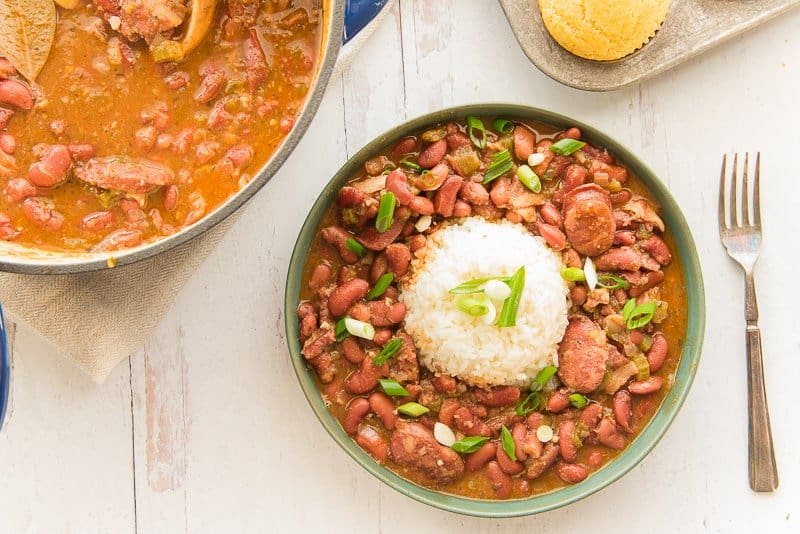

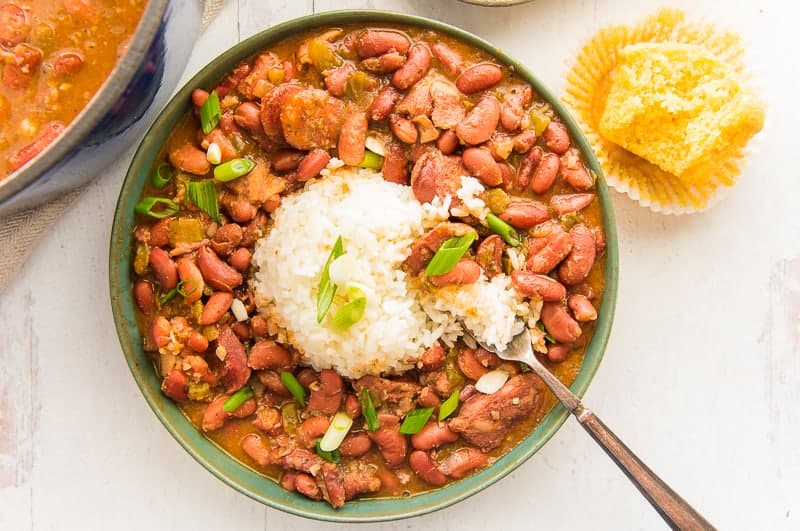


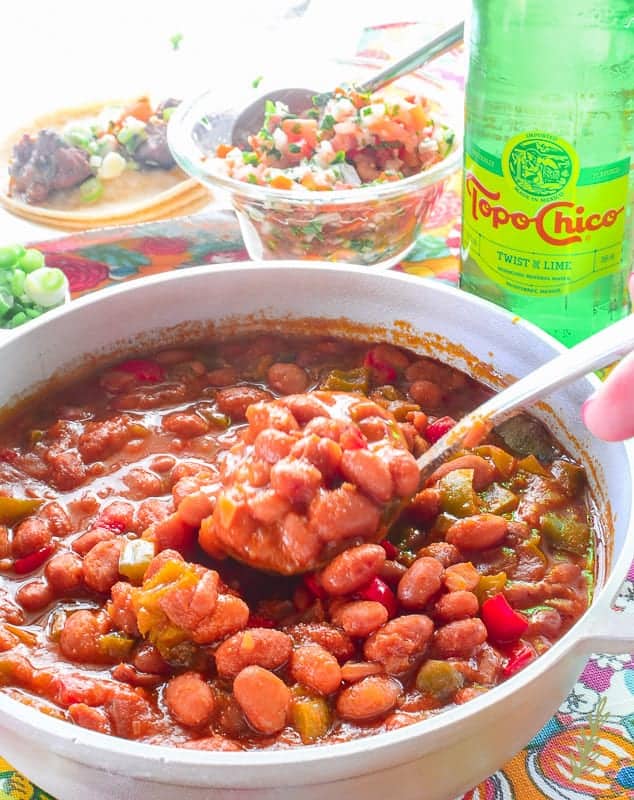


This is excellent, with the addition of the many spices that come through as an increase in overall blended flavor. Best Creole red beans and rice we have had! Thank you! We bring the pot of beans to a boil on the stove then cook ours in the oven at 320F. They took 100 min to get to the right texture. Well done and thank you!
You’re welcome, David!
Great food. I like your style.
Welcome, Bart. And thank you!
I love all the spices in this and the ham broth adds so much flavor! It’s such a hearty side that goes with any meal!
Yes, I’m all about adding as much flavor as possible.